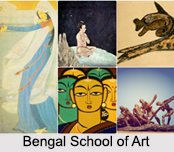 Bengal School of Art was a special form of art that thrived in India during the British rule in the early 20th century. This form of art was connected with the nationalism movement in India, but it was not supported by the art administrators of British Empire. It was an art movement and a style of Indian painting.
Bengal School of Art was a special form of art that thrived in India during the British rule in the early 20th century. This form of art was connected with the nationalism movement in India, but it was not supported by the art administrators of British Empire. It was an art movement and a style of Indian painting.
History of Bengal School of Art
Bengal School of Art originated in Bengal, primarily Kolkata and Shantiniketan, and flourished throughout India during the British Raj in the early 20th century. It was associated with Indian nationalism (swadeshi) and led by Abanindranath Tagore (1871-1951), but was also promoted and supported by British arts administrators. This new group of painters refused the art of Raja Ravi Varma as copied and westernized.
The Bengal School of Art arose as an avant-garde and strong activist movement reacting against the academic art styles that was promoted in India previously. Following the influence of spiritual ideas of India in the Western countries there were suggestion by British teachers to imitate the style of Mughal art form. This caused controversy, which led to strikes by students and complains from local press that included the nationalists who considered it to be a retrogressive move. The move of protest by students and press was well supported by Abanindranath Tagore, a nephew of the Bengali literature genius Rabindranath Tagore.
Tagore also painted numerous such paintings that were influenced by Mughal art, a style that he believed expressed India`s distinct spiritual qualities, as opposed to materialism of the west. One of the popular paintings by Tagore named "Bharat Mata" or Mother India depicted young woman that was portrayed with four arms in the manner of Hindu deities, holding objects symbolic of India`s national aspirations. Later, Tagore attempted to develop links with Japanese artists as part of an objective to build a pan-Asianist model of art. The Bengal school`s influence in India declined with the spread of modernist ideas in the 1920s.
In the 19th century British came across the Kalighat paintings, made by local artisans called "patuas". The famous Kalighat Temple is considered as one of 18 "Shakti Peethas" which became a demanding centre of pilgrimage for the Hindus. Here, the local artists drew images of Kali and other Gods and Goddesses on Paper or Cloth, which were sold to the pilgrims as keepsake. The "patuas" also drew pictures of rich Bengali aristocrats and their lifestyle which is called as "Babu Culture". The Kalighat paintings played a lot of roles as, that of artwork, illustrated manuscripts, social humorous illustrations and keepsakes. The paintings were done in natural colours with neutral backgrounds of the paper. Turmeric powder, indigo, chilli powder, were some colour bases used in the 19th century. The black charcoal colour was used broadly to make the outlines of figures on paper. The flat brush strokes and the non existence of shadowing on the figures is a distinctive way of painting.
In the 1930s the popularity of Kalighat paintings reduced as lithographs as oleographs quickly reached the masses.
Features of Bengal School of Art
Bengal school of Art was called the Renaissance because this movement endeavoured for revitalization of the Indian ancient and medieval traditions. The paintings were simple and model paintings with attractive colour method technique. Bright colours were not used in such paintings. Bengal painters have made best possible efforts to fetch in the tempo, linear gracefulness and deportment of Ajanta in their painting. Influence of Mughal and Rajasthan School can also be seen. Elegant and advanced figures and the paintings displayed skilfully exposed light and shade without any inflexibility.
Prominent Artists of Bengal School of Art
EB Havell, Abanindranath Tagore, Nandalal Bose, Gaganendranath Tagore, Asit Kumar Haldar, Jamini Roy, Ramkinkar Baij, Rabindranath Tagore are the prominent artists of Bengal School of Art.




